The 300 Remington Ultra Magnum (300 RUM) undoubtedly delivers flat shooting and hard hitting performance, but is it really a good choice for most hunters?
Most hunters would probably agree that, on paper anyway, the .300 Remington Ultra Magnum looks like a fantastic hunting cartridge. Capable of launching a heavy bullet at a very fast velocity, the .300 Ultra Mag delivers extremely flat trajectories and hard hitting performance at long range. The .300 RUM undoubtedly deserves the “Ultra Magnum” moniker, but that incredible performance does come at a price.
The magnum era in North America kicked off with the introduction of the 7mm Remington Magnum and .300 Winchester Magnum in the early 1960s. Other magnum cartridges like the 30-378 Weatherby Magnum and 300 WSM have come along since then, giving hunters looking for serious magnum performance no shortage of options to choose from.
So, what was Remington trying to accomplish when they released the .300 Remington Ultra Magnum in the late 1990s?
In this article, I’m going to discuss the history as well as the strengths and weaknesses of the 300 Remington Ultra Magnum in detail. I’ll also provide some information on how the 300 RUM stacks up next to the .300 Winchester Magnum so you can decide which one best fits your needs as a hunter.
Before we get started, I have an administrative note:
Some of the links below are affiliate links. This means I will earn a small commission (at no extra cost to you) if you make a purchase. This helps support the blog and allows me to continue to create free content that’s useful to hunters like yourself. Thanks for your support.
Additionally, I recorded an entire podcast episode on this exact subject. If you’d rather listen than read, click the appropriate link below to listen to this episode on your preferred podcasting service.
300 RUM Podcast
Apple | Google | iHeart | Pandora | Spotify
300 Remington Ultra Magnum History
Around the same time ballisticians at Winchester were doing their initial development of what would become the Winchester Short Magnum line of cartridges, the folks at Remington were also working on a major cartridge development project. Interestingly enough, both companies decided to use a larger diameter, beltless case as the basis for their projects.
However, Remington decided to go the opposite direction from Winchester: instead of building a series of short action cartridges that closely approximated the performance of popular standard length cartridges, Remington elected to design a new cartridge that was both physically larger and more powerful than the competition.
Released in 1999, the .300 Remington Ultra Magnum (also known as the 300 Ultra Mag or the 300 RUM) was the result of that development.
Remington built the .300 Ultra Mag using a modified .404 Jeffery case necked down to use .308″ bullets, slightly shortened to 2.85″, and blown out to maximize case capacity. They also gave the cartridge a .534″ rebated rim that’s compatible with a standard magnum size bolt face. Finally, since the 300 RUM uses a beltless case, it has a 30 degree shoulder for headspacing.
With an overall length of 3.6″, it’s a little bit longer than cartridges like the .30-06, 7mm Rem Mag and .300 Win Mag. That extra length means the .300 Ultra Mag must be used in magnum (instead of long/standard) length action rifles.
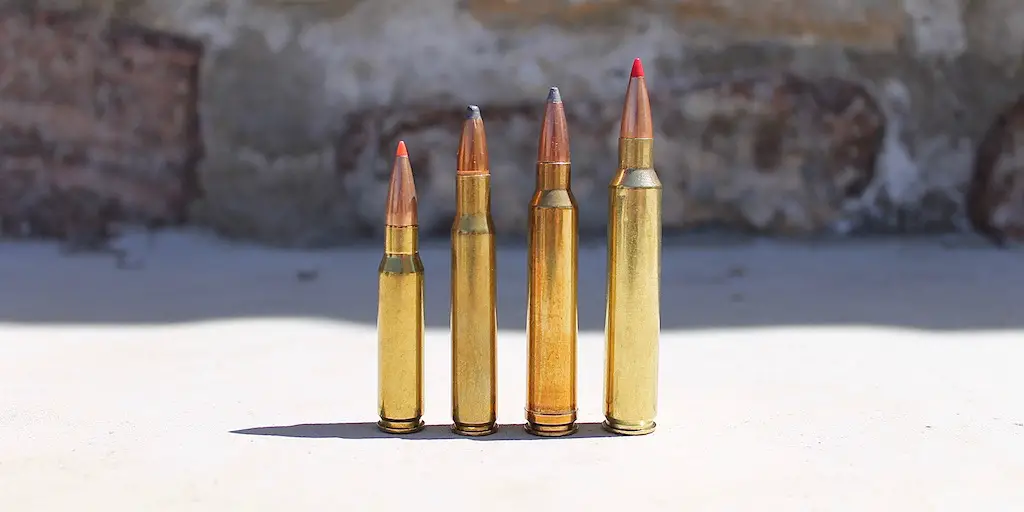
However, that extra length, combined with the fact that the cartridge has a .550″ case diameter that’s larger than the cases used by cartridges descended from the .375 H&H (.513″), means the .300 RUM has a gigantic case capacity.
Interestingly enough, this was the first .30 caliber magnum cartridge that Remington had ever developed and the 300 RUM joined the 6.5mm Remington Magnum, 7mm Remington Magnum, 8mm Remington Magnum, .350 Remington Magnum, and .416 Remington Magnum cartridges previously released by the company.
300 RUM Ballistics
Typical 300 RUM ballistics are a 150gr bullet at 3,450 fps (3,965 ft-lbs), a 180gr bullet at 3,250 fps (4,222 ft-lbs), or a 210gr bullet at 2,920 fps (3,975 ft-lbs). The .300 Ultra Mag is known for lots of power along with minimal bullet drop and wind drift at extended range. That power comes at the expense of lots of recoil though.
300 Ultra Mag vs 300 Win Mag
The .300 Ultra Mag can fire the same weight bullet approximately 200-300fps faster than the .300 Win Mag. This results in a flatter trajectory, more resistance to wind drift, and more retained energy at longer range. However, the .300 Ultra Mag also has a lot more recoil than the .300 Win Mag.
That’s how the two cartridges compare to each other in a nutshell. As we drill down into the details of their similarities and differences though, several especially important factors emerge.
First, the .300 Win Mag and the 300 RUM both fire the same .308″ diameter bullets. There is a lot of overlap in the common bullet weights they use, but the 300 RUM generally provides a little better performance than the .300 Win Mag with longer and heavier bullets.
For instance, the 300 Win Mag commonly uses bullets in the 150-210 grain range with 150 grain, 165 grain, 180 grain, and 200 grain bullets being most common. The .300 RUM typically uses bullets in the 150-220 grain range with 150 grain, 165 grain, 180 grain, 200 grain, 210 grain, and 220 grain bullets being most common
Since there’s so much overlap in their common bullet weights, rifles for both cartridges typically use a 1:10″ rifling twist.
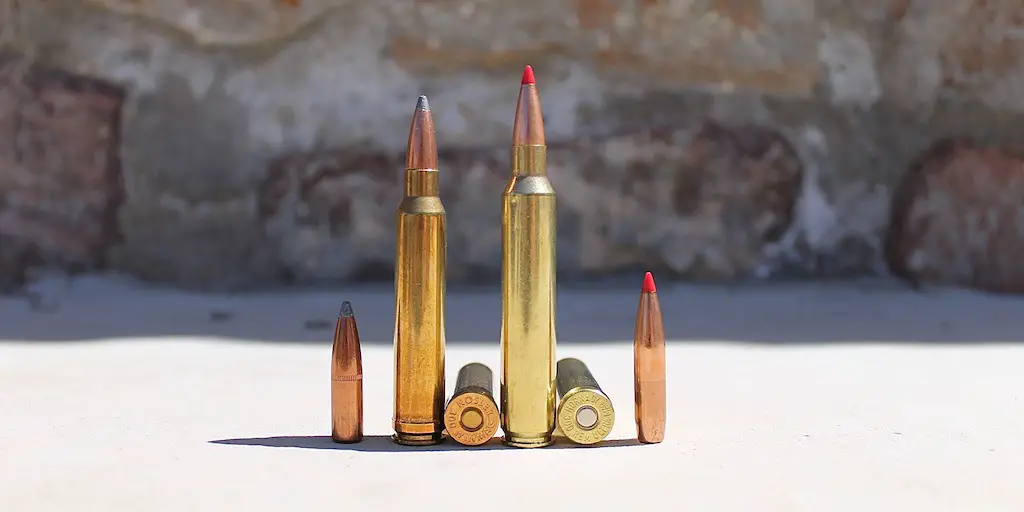
Perhaps the biggest difference between the two cartridges is the massive advantage the .300 RUM has in powder capacity though.
Since it has a longer (2.85″ vs 2.62″) and larger diameter (.550″ vs .513″) case, the .300 Ultra Mag also has about 25% more case capacity than the .300 Win Mag. That additional powder capacity is how the .300 RUM can fire the same weight bullet quite a bit faster than the .300 Win Mag.
At the same time, the 300 RUM has a slightly longer case neck than the .300 Win Mag (.306″ vs .264″). In general, a longer neck helps hold a projectile securely and concentrically, both of which can help with accuracy.
Additionally, the .300 RUM has a minimally tapered beltless case with a 30 degree shoulder. The .300 Win Mag uses a belted case with a 25 degree shoulder. At the same time, the .300 RUM uses a rebated rim case while the .300 Win Mag does not.
The fact that the .300 RUM has a beltless case is something of an advantage when it comes to reliable feeding. On the other hand, the fact that the .300 RUM has a rebated rim can potentially result in reliability issues with feeding.
So, take both of those things for what you will. For the most part, both the .300 RUM and .300 Win Mag both generally have very good reputations for reliable performance in most rifles.
Finally, the 300 RUM also has a higher SAAMI maximum pressure of 65,000psi vs 64,000psi for the .300 Win Mag.
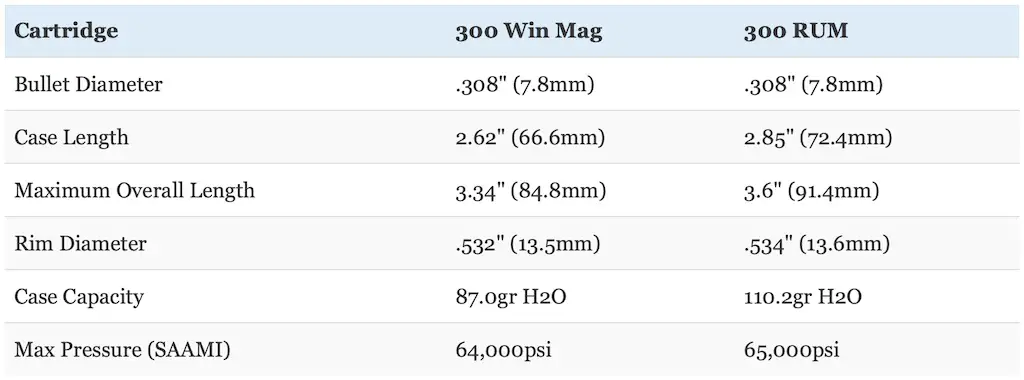
Note: while the powder capacity figures listed above do give a good indication of the differences between the two cartridges, exact case capacities vary slightly according to the brand of brass used.
The table below compares 180gr Nosler AccuBond (.507 BC) loads for each cartridge. This data is for Nosler Trophy Grade factory ammo using a 200 yard zero.

Just as you’d expect, the .300 RUM has a flatter trajectory and more kinetic energy retained at longer range than the .300 Win Mag. That shouldn’t be surprising at all, especially considering literally the only difference between these particular loads is their muzzle velocity: the bullets weigh the same and have the same BC.
Specifically, the .300 Ultra Mag shoots the exact same bullet 300fps faster than the .300 Win Mag. This results in the 300 RUM having a flatter trajectory with about 7.6″ (24%) less bullet drop at 500 yards. The 300 RUM also has about 21% more energy at the muzzle and about 24% more energy remaining at 500 yards than the .300 Win Mag.
The chart below compares how much a 10 mile per hour crosswind impacts those same loads for each cartridge out to 500 yards.

Once again, the cartridges perform pretty much like you’d expect. At 500 yards, there’s just 2.2″ separating them. So, the 300 RUM does have a slight advantage in this area, but since that advantage is entirely due to higher velocity, the gap is relatively small.
Now let’s talk about recoil.
The table below compares a couple of handloads that approximate the performance of the factory loads given above when fired from identical rifles.
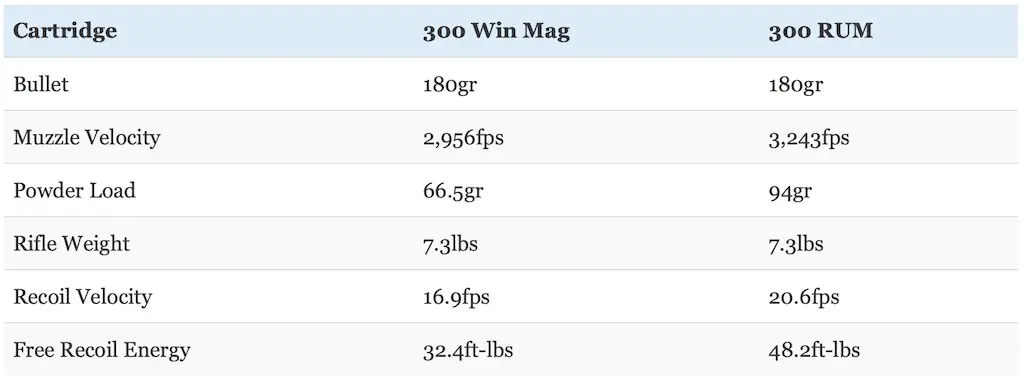
Felt recoil will vary from shooter to shooter and rifle to rifle, but free recoil energy is still a useful way to compare cartridges.
As you can see, the 300 RUM delivers those ballistic advantages over the .300 Win Mag at the expense of nearly 50% more free recoil energy.
Yes, you read that right: the .300 Remington Ultra Magnum has almost 50% more free recoil energy than the .300 Win Mag. That’s really saying something too because the .300 Win Mag is known for having a relatively stout recoil itself.
Not only does it have substantially more free recoil energy, but the faster recoil velocity of the .300 Remington Ultra Mag makes for a sharper “kick.” Added together, the result can be tooth rattling recoil.
Having a properly fitted and well designed stock with a good recoil pad can mitigate felt recoil to a certain degree. The same goes for a muzzle brake.
However, combining a muzzle brake with a fire breathing magnum like the .300 RUM can result in some really unpleasant muzzle blast. Make sure you wear ear protection if you go that route!
So where do we stand overall with the 300 RUM vs 300 Win Mag?
Basically, the 300 RUM is capable of firing the same weight, or slightly heavier bullet at a faster velocity than the .300 Win Mag. That translates into a flatter trajectory, a little more resistance to wind drift, and more kinetic energy at typical hunting ranges.
If you want to use the 300 RUM for elk hunting, the additional couple hundred ft-lbs of kinetic energy the cartridge provides might come in handy, especially at extended range. However, the .300 Win Mag is plenty powerful for that work and I doubt any elk will be able to tell the difference.
The flatter trajectory and more resistance to wind drift of the 300 Remington Ultra Magnum can also help with shot placement. This does make the cartridge a little bit more forgiving of range or wind estimation errors than the 300 Win Mag. However, that extra recoil of the .300 RUM can negatively impact shot placement with some shooters.
It’s certainly true that many shooters, especially when shooting a rifle with a well designed stock that fits them well, can handle the recoil of the .300 Ultra Mag without any trouble. Those shooters are better suited to take advantage of the improved ballistics of the 300 RUM vs the 300 Win Mag.
On the other hand, that’s not the case with everybody.
Don’t underestimate the impact that recoil has on the ability of a person to shoot accurately either. Regardless of how well a given person handles recoil, all other things being equal, they will absolutely shoot better with a milder recoil.
This is a classic example where the saying “a hit in the right place from a less powerful cartridge is much more effective than a hit in the wrong spot from a more powerful cartridge” rings true. It’s a plain and simple fact that the 300 Ultra Mag has more recoil than many hunters can handle.
Now let’s talk about barrel life.
Since the two cartridges use the same diameter barrel, throat erosion occurs quite a bit faster with the 300 RUM because it has a lot more case capacity. Simply put, burning more powder in an equally sized space will result in shorter barrel life.
Not surprisingly, the 300 Ultra Mag has a reputation as a barrel burner. Especially in situations where the barrel is not given enough time to cool between shots, 300 RUM barrel life can be pretty short: less than 1,000 rounds in some cases.
This might not be an issue for some hunters, but typical 300 RUM barrel life is usually significantly shorter than typical .300 Win Mag barrel life.
This means that, in general, the 300 RUM will wear out barrels faster than the .300 Win Mag will (which can be a bit of a barrel burner itself). Exactly how fast that occurs depends on a number of factors like the quality of the barrel, the exact ammunition used, etc.
So, along with recoil, the difference in .300 Win Mag vs 300 RUM barrel life, is certainly something to keep in mind.
All things considered though, both cartridges are very accurate, flat shooting, and hit hard enough for use on a wide variety of game at practical hunting ranges. Regardless of whether you’re using a .300 Winchester Magnum or a 300 Remington Ultra Magnum, no pronghorn, mule deer, or elk will go far if you put a well constructed bullet into the vitals.
Of the two cartridges though, the .300 Win Mag is by far the most popular with hunters. This is reflected in the prices, availability, and variety of factory ammunition and hunting rifles currently in production for each cartridge.
So, even though the 300 RUM does have some significant advantages on paper, those advantages must be weighed against the very real downsides of the cartridge.
The .300 Win Mag is a fantastic hunting round and it’s a whole lot easier to find .300 Win Mag rifles and loaded ammunition. Recoil is much more manageable and the cartridge is generally much easier on barrels.
For these reasons, the .300 Winchester Magnum is probably the better all around choice for most hunters.
That said, the 300 RUM gives hunters the ability to wring more performance out of a .30 caliber magnum cartridge for long range shooting and hunting. If you can deal with the recoil and want a flatter shooting and harder hitting cartridge, then the .300 Ultra Mag might make sense for you.
300 Ultra Mag Ammo
While not extremely popular in absolute terms, the 300 Remington Ultra Magnum does have a somewhat dedicated following and there is a pretty good supply of 300 Ultra Mag ammo.
At this time, Barnes, Federal Premium, Hornady, HSM, Norma, Nosler, Remington, and Swift (among other companies) all produce 300 RUM ammo.
Some companies, most notably Remington, have manufactured .300 Ultra Mag ammo of varying power levels. For instance, it’s sometimes possible to find .300 RUM loads that are downloaded to approximate the performance of the .30-06 or the .300 Win Mag as well as other loads that offer the full level of performance the cartridge is capable of.
Those reduced loads are good options for hunters in situations who want to use their .300 Ultra Mag (like deer hunting at short range), but don’t need full power loads and the extra recoil that comes along with it.
While it’s not extremely difficult to find, 300 RUM ammo is usually a little more expensive and not quite as easy to find as more popular cartridges. That said, most sporting goods stores, especially the big retailers in the USA, keep some 300 Ultra Mag ammo in stock. Some of the smaller gun stores will probably have some on hand as well, but availability can be uneven.
Fortunately, availability of ammunition is usually pretty good online though and most of the bigger retailers typically have a good selection of quality factory 300 RUM ammo in stock.
Additionally, the .300 Ultra Magnum is a very good cartridge for reloaders. Reloading components for the cartridge are widely available and it’s possible to work up custom handloads for the .300 RUM that safely improve upon factory ammo performance.
Finally, since it uses the same .308″ bullet size that’s also used by the .308 Winchester, .30-06 Springfield, .300 Win Mag, and .300 PRC (among others), reloaders have access to a good number of outstanding quality bullets in the 180-220 grain range suitable for use on a wide variety of game to choose from.
For instance, the Barnes TTSX, Hornady ELD-X and GMX, Nosler E-Tip, AccuBond, and Partition, Swift Scirocco and A-Frame are all very good bullet options for the .300 RUM.
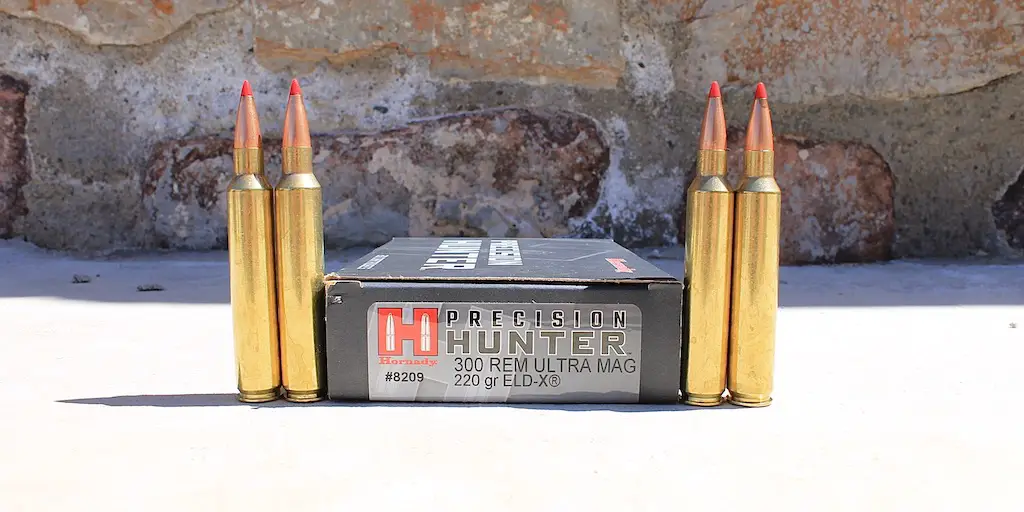
300 RUM Rifles
There is currently a decent, but not gigantic, selection of high quality rifles available for the 300 Remington Ultra Magnum.
While they’re not the only options available, the Browning X-Bolt and Remington 700 are probably the two most common bolt action 300 RUM rifles. Fierce Firearms and Christensen Arms also manufacture some nice bolt action rifles in .300 Ultra Mag. Ruger and Savage also manufactured rifles in that chambering at one point, so it’s possible to find them on the secondary market from time to time.
Note that most rifles chambered in .300 Ultra Magnum typically have a longer barrel: typically 24″ or 26″. Since the cartridge has a gigantic case capacity, those longer barrel lengths are necessary to get maximum performance out of the 300 RUM.
That’s not necessarily a bad thing, but just keep it in mind. If you’re looking for a shorter, lighter, and/or handier rifle, then you probably should choose a cartridge other than .300 Ultra Mag.
BUY AN EXCELLENT 300 ULTRA MAG RIFLE HERE
Final Thoughts On The 300 RUM
The 300 RUM certainly offers some significant ballistic advantages to hunters. In fact, it ranks right up there next to the .30-378 Weatherby as the flattest shooting and hardest hitting .30 caliber cartridge in widespread use. That said, there are real disadvantages in terms of excessive recoil and shorter barrel life that come with the cartridge.
For hunters who can deal with the disadvantages of the .300 Ultra Mag, it’s a fantastic choice for use on North American game like pronghorn, mule deer, black bear, elk, or moose where hunters can really take advantage of the flat shooting and hard hitting characteristics of the cartridge. The same goes for hunting game like blue wildebeest, kudu, and eland in Africa or game like nilgai in south Texas.
Make no mistake: the .300 Remington Ultra Magnum is an excellent cartridge. Get a rifle with a good recoil pad and a stock that fits you properly, learn to shoot it accurately, and I’m sure you’ll be happy with how it performs for you afield.
Do you have a rifle chambered in 300 RUM that you’re itching to take on a hunt?
Book an incredible black bear hunt here.
Book an outstanding Africa hunting safari here.
Are you curious about how the 300 Remington Ultra Magnum stacks up against other popular (and not so popular) 30 caliber cartridges? If so, you’ll probably enjoy my podcast episode on 30 caliber cartridges. In this episode, I talk about the history, pros, cons, and recommended uses for basically everything from the 30 Carbine all the way up to the 30-378 Weatherby Magnum and 300 PRC as well as everything in between (to include the 300 RUM).
This is a fantastic episode, so just click the appropriate link below to listen to that episode on your preferred podcast app. Be sure to hit that “Subscribe” or “Follow” button in your podcast app to receive future episodes automatically (for free)!
Ultimate Guide To 30 Caliber Cartridges Podcast
Apple | Google | iHeart | Pandora | Spotify
Enjoy this article about the 300 Remington Ultra Magnum? Please share it with your friends on Facebook and Twitter.
The Lyman 50th Edition (p260-262, p263-264) and Hornady 10th Edition (p574-585, 596-607) reloading manuals provided information for the history of 300 Win Mag and 300 RUM as well as data used to compare their size. The data used to compare the trajectory and recoil of the cartridges was obtained from Nosler (here, here, and here). Maximum pressure for the .300 Win Mag and the .300 Remington Ultra Magnum were obtained from SAAMI (p30). GMDR provided case capacity data for the 300 Remington Ultra Magnum and the .300 Winchester Magnum. I used Shooters Calculator to compare trajectories, wind drift, and recoil for the cartridges.
Make sure you follow The Big Game Hunting Blog on Facebook, Instagram, Twitter, and YouTube.
NEXT: BEST 6.5 CREEDMOOR AMMO FOR HUNTING ELK, DEER, AND OTHER BIG GAME
John McAdams is a proficient blogger, experienced shooter, and long time hunter who has pursued big game in 8 different countries on 3 separate continents. John graduated from the United States Military Academy at West Point and is a veteran of combat tours with the US Army in Iraq & Afghanistan. In addition to founding and writing for The Big Game Hunting Blog, John has written for outdoor publications like Bear Hunting Magazine, The Texas State Rifle Association newsletter, Texas Wildlife Magazine, & Wide Open Spaces. Learn more about John here, read some of John’s most popular articles, and be sure to subscribe to his show: the Big Game Hunting Podcast.


I love my 300 RUM. I’m not the best shot the gun makes up for that. Shot seven animals, seven shots, seven kills. A second shot is never needed. They don’t go far. I am getting concerned I can not find ammo. When I do it is over $4.00 a round. Keep that in mind.
Greetings, I have both a 300 rum (700 rem) and a 338 win mag and a 338 federal. . I prefer the 338 win mag as althouth I do not think is more accurate, It is pleasant to shoot. The 300 RUM is a safe queen. It has such unpleasant recoil that is rarely see’s any hunting trips. The 338 federal is also a great round to 200 yards. The 338 feral (pun intended) is a great round for most 48 states wildlife.
Now that I am older, most my shots on bear (my favorite hunts)are within 100 yards. No need for the 300 RUM.
Where I live, shooting deer off the back deck, my favorite is open sight Marlin (JM barrel) 45-70. Then comes the hassle of firing up the forklift and driving out and retreiving the deer. Yea, I know, sometimes I have a cocktail before gutting and skinning. Alas, I digress. Unless you are a serious Alaska hunter for mountain goat, big horn sheep or Dall sheep, the 300 RUM is overkill with any other game. It takes up room in a safe. My better half can give it away after I expire, that sucks because I am past my “use by date”. Just my opinion.
Sir, I must disagree very strongly with your straight out statement about the .300RUM rifle!!! You must know , due to the information you provide about the RUM that it is a remarkable and deadly rifle but you also must have something personal against this rifle. You must know that the first thing one does when purchasing a rifle with this power you have a professional install a good compensator which will deduct the recoil to equivalent to if not less than a .270 of any make!
I guess this is why most of the native hunters and professional guides i Canada and Alaska carry and use the .300RUM you have personally condemned! I’m 74 years old and carry my .300RUM with light loads for white tails and have taken brown bear, moose, Elk and a number or each plus other large game a have only had to fire a second shot once and that was my fault and not the rifles but that animal went down but to keep it from suffering I did fire once more!
Tell the whole story about a firearm if you are to be fair and professional which is called making money off your fair and expert knowledge!!
I must add one more thing to my comment about the .300RUM. I have a Son who has hunted with me since he was 6 years old. He was 14 when I first got him to actually fire my RUM understandably . But after I had taken my whitetail buck at about 180 yards and were waiting for an hour for a buck to show up so he could get one I asked him to just try the .300 and if he didn’t like it I would never ask him again so he agreed. I agree he was a large 14 year old , muscled and nearly 6 foot tall but still a normal 14 year old! Once this deer walked not more than 80 yards out so I told him where to place th cross hairs not wanting to change my sight settings. Being a good shot normally he did flinch’s bit expecting a heavy recoil but altho the bullet was slightly forward and high I flipped the 8 point buck 260 degrees and about eight sideways. He looked me in surprise and not at taking a nice deer but at the rifle he was now looking at! He said “ You at right Dad, this thing isn’t much more than my .243 and I think less than your .270! This was prof enough for me that my opinion that I was correct about the .300RUM!
Thank you for allowing to comment on my favorite rifle for many uses from mountain sheep to Water Buffalo and Brown Bear!
In the late 90’s I bought a Ruger #1 in .300 G&A or .300 Broadcreek.
It was a rifle made by the Broadcreek rifle works IIRC in NJ.
It was a 404 Jeffries case neck down to .30.
It has a fluted SS bbl. and a George Vies muzzle brake.
My question is, how close to the Remington .300 ultra mag is this cartridge?
I can’t find any info out on the web.
I do know I can’t get 100 rounds out of a pound of powder!
It will push a 180g bullet at 3250!
Does any one know of this round?
I have not hunted with this rifle yet but have reloaded about 100 rounds. the recoil with the muzzle brake is manageable.
My question is is the RUM the same as the the other two?
Broadcreek Rifleworks was in Delaware and Mike Ruggerio was the smiths name. He was the specialist in Ruger No1s. Pretty sure he’s out of the business now.
The 300RUM should net you about 70ish rounds per pound depending on your load. I think they are both about the same length, but the blown out body of the RUM uses up about 95 grains for a relatively factory load. I’d guess that’s where the difference lies.
I’ll have to say that I was pleased to see that you mentioned Remington made 3 levels of ammunition for this caliber. However, now it’s next to impossible to find and brands that make these 3 levels. Only the bullet weight change is available.